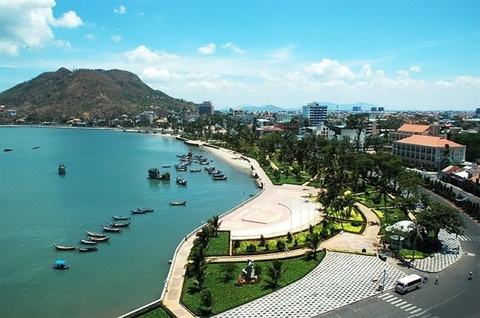
Front Beach of Vung Tau. Ba Ria – Vung Tau has taken advantages of its natural beauty, including sea and beaches, for tourism development. — VNS Photo/ Ngoc Hai.
The southern coastal province of Ba Ria – Vung Tau has exploited its natural beauty and taken advantages of its oil and gas sector for economic development, turning itself into a sustainably developed region in the Southern Focal Economic Zone of Viet Nam.
Situated about 3km to the southwestern of Vung Tau City, the 30sq.m Go Gang Island has geological advantages and natural beauty. Go Gang Island is seen as a new area where an economic zone could be established in Ba Ria – Vung Tau Province.
The Construction Department of Ba Ria – Vung Tau Province has proposed adjustments for functional areas of Go Gang Island on 1,389 ha, for a population of about 65,000, with 795ha of land to be used as urban construction land. Buildings in the area could have up to 60 stories.
Go Gang Island would have eight zones including residential areas, functional complexes and public conveniences; parks and greenery, water surface, amusement parks, airport and ground services, infrastructure and a fishery centre.
When the Go Gang Airport becomes operational, the provincial authorities will have 200ha of land for new urban area projects in Vung Tau City.
Two big urban area projects have been established, with one at Vung Tau Airport with an urban area of 35ha, a central park of 46ha, a logistics and service centre of 24ha, a financial and technological centre of 20ha; and an urban complex of 25ha.
The other project is located on 270ha in Ward 12 of Vung Tau City. This includes a 60ha ecological urban area, a 20ha office and trade centre, a 15ha business centre, the 25ha Marina Urban Area, a 15ha sport centre and square.
In addition to efforts to upgrade air transport facilities, Ba Ria – Vung Tau Province has invested in land transport projects, especially a project to build the Bien Hoa – Vung Tau Expressway.
According to the province, the increase in traffic volume on National Highway No 51 (linking HCM City with Vung Tau City) and the rapid growth of residential areas along the expressway have overloaded the expressway in the last few years.
This could be eased by the Bien Hoa – Vung Tau Expressway. Construction of the expressway is scheduled to start in 2021 and be completed two years later. The new expressway would link Ba Ria – Vung Tau Province with other localities in the Southern Focal Economic Zone.
Ba Ria – Vung Tau has asked the central Government to conduct a feasibility study to build a railroad to connect the Cai Mep – Thi Vai Port under a Public-Private Partnership.
In addition, transportation projects will connect with the Cai Mep – Thi Vai Port including Phuoc An Bridge, National Highway No 56 (to avoid Ba Ria City), Long Son – Cai Mep Highway, and the Ba Ria – Vung Tau Highway.
Tourism
With a coastal line of over 30km and Con Dao Island, Ba Ria – Vung Tau Province has advantages for tourism development. However, the provincial authorities have focused on the oil and gas sector and its deep-water seaports.
In recent years, the province has paid more attention to the tourism sector. Under the province’s plan for the next decade, it aims to welcome 8.6 million visitors (including 1.4 million foreign travellers) in 2025, bringing revenue of VND31 trillion (US$1.33 billion).
Ba Ria – Vung Tau Province is expected to maintain growth rate of 30 per cent – 35 per cent annually for its tourism sector between 2020 and 2025.
The province’s planning for development of its tourism sector for the next decade also identifies priorities for investment projects until 2025 including development of a tourism urban town (Vung Tau City), two national tourist zones (Con Dao, Long Hai – Phuoc Hai), sea and island tourist products, and tourism entertainment services.
The province will give priority to four tourism development programmes, including human resource development; regional tourism brand promotion; preservation, embellishment and development of tourism resources; and major tourism infrastructure facilities. — VNS